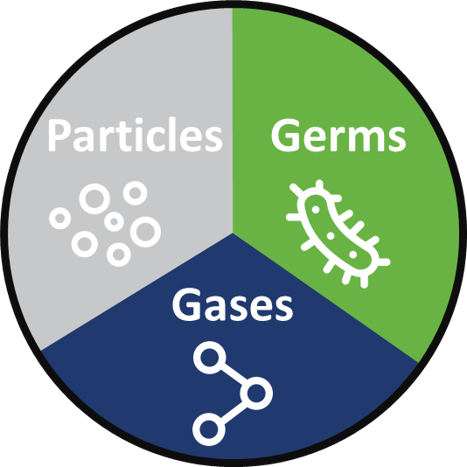While it may not have been a concern five years ago, air quality in schools has become an important issue. After all, COVID-19, flu and colds spreads via aerosol droplets indoors, and the longer a person is exposed to those droplets, the greater the risk of infection. What’s more, virus and other germs particles can float up to 60 feet, especially during talking, singing, coughing, laughing and even breathing. We want our kids, teachers and administrators to go to school and not worry if they may get sick while at school.
Even beyond COVID-19 and other illnesses that can easily spread in schools, parents and school staff members

want school air to be as free from bacteria, dust, allergens and other contaminants as possible. Good air quality not only helps keep students and staff safe, but also directly impacts:
- Students and staff absenteeism
- Test scores
- Teacher retention rates.
We all want to keep kids in school as much as possible, but we also need to keep teachers and staff in school to maintain the educational environment.
Every school from public to private benefits from improved indoor air quality. With federal funding , upgrading the HVAC system and adding portables are now more obtainable than ever.
How Could Poor Air Quality be Effecting Our Students and Staff?
Poor air quality could have both short and long-term effects on student and staff health and cognitive ability.

What Funding Is Available?
Federal funding has been established to support schools in keeping students and staff safe including $2.2 trillion of federal funding under the CARES Act : $190B for K-12 (ESSER) and $75B for Higher Ed. (HEERF), equating to $2.6k/student. Under these programs, 90% of the funds have been allocated for improving school safety, including indoor air quality. There is funding available via the Federal Funding Portal.
What Upgrades Should We Consider for Our School?
The EPA, CDC, and ASHRAE guidelines recommend HEPA portable air purifiers and UVC technology in every classroom. School districts and universities from Seattle, Washington to New Jersey have upgraded their HVAC systems and added portables to allow for safer school days.
What Should We Add to the School HVAC Systems?
Most schools already have heating, ventilation and cooling (HVAC) systems at work. However, these systems are often out-of-date and may not be doing a great job of keeping the air clean. Schools can update their HVAC systems with UV air purification, PCO and carbon filters, which have become more obtainable with the federal funding. We explore each technology to help schools make more informed decisions going forward.

ULTRAVIOLET GERMICIDAL IRRADIATION (UGVI)
Reduces Germs: Viruses, Bacteria, Fungi
- Germs can pass through filters due to their size (viruses are 0.004-0.3microns)
- UV-C inactivates microorganisms by disrupting the DNA, rendering them harmless

PHOTOCATALYTIC OXIDATION (PCO) & CARBON FILTERS
Breakdown and Capture Chemicals & Gases
- PCO technology, energized by UVC, breaks down contaminants (chemicals, gases, and biologicals) into H2O and CO2
- Carbon filters can only capture odors and VOCs, not destroy, and reach a saturation point, at which point re-release VOCs into the environment – not a long-term solution.
Do We Also Need HEPA Air Purifiers?
According to the U.S. Environmental Protection Agency, High Efficiency Particulate Air Purifiers, also known as HEPA filters, used alongside buildings’ HVAC systems, offer an effective way to remove virus particles from the air and help reduce the spread of COVID-19 and other illnesses.
Each HEPA filter has a rating that indicates how effective it is at removing particles form the air. The SKYE Portable Air Purifier is rated H-13, meaning it removes 99.97% of 0.3 micron particles, down to 0.1 micron. For reference, a micron is one-millionth of a meter. Human hair measures between 10 and 100 microns in diameter, so we’re talking about very small particles being removed from air circulation with the Air Health HEPA filter.
Can I Buy Air Purifiers in Bulk?
You may wonder whether its possible or cost effective to equip a school with enough portable air purifiers or HVAC air purifiers to make a difference in air quality. The answer is yes. You can purchase Air Health purifiers in bulk and get a substantial discount off the purchase price. For example, if you purchase 20 portable air purifiers, you’ll get a significant discount. If you’re thinking of purchasing more than 20, we may have an even better deal for you, so please give us a call .
Use our portable air purifier calculator to find out how many air purifiers your school needs based on square footage.
 US Dollars
US Dollars
